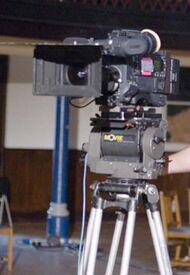Varicam
Topic: Engineering
 From HandWiki - Reading time: 8 min
From HandWiki - Reading time: 8 min
 | |
| Type | Video camera |
|---|---|
| Inception | 2001 |
| Manufacturer | Panasonic |
| Website | pro-av |
Varicam, originally stylized as VariCam, is a brand name associated with specialized Panasonic video cameras that are mostly used to imitate the look and feel of motion picture cameras. They have been used to record scenes for many feature films. The recording framerate of Varicam cameras can be varied between at least 1 to 60 frames per second, offering flexibility in creating rapid or slow motion effects. Because film has traditionally been shot at 24 frames per second, while NTSC video uses 29.97 frames per second, Varicams can be used for both high end video and film production. Panasonic applied the VariCam brand for the first time to the AJ-HDC27.
Although the initial capital costs of the cameras are high, their low operating cost has made them popular among independent filmmakers, and they are often available to rent from camera rental companies. The Varicam range has now matured into its latest generation, and is widely used in TV production, as well as film.[1][2]
Range
| Model | Weight | Size[lower-alpha 1] | Sensor | Lens mount | Media | Framerates | Introduced | Current |
|---|---|---|---|---|---|---|---|---|
| HDC27V/F[3][lower-alpha 2] | 9.9 lb 4.5 kg |
5 1⁄4 in × 8 1⁄16 in × 13 in 133 mm × 205 mm × 330 mm |
3×2/3" | B4 | 1⁄4" DVCPRO | 4–60 (720p) | 2001[4] | |
| HDC27H[5][lower-alpha 2] | 10 lb 4.7 kg |
5 1⁄4 in × 8 1⁄16 in × 12 3⁄8 in 133 mm × 205 mm × 314 mm |
2005[6] | |||||
| HPX2700[7] | 11 lb 4.9 kg |
5 7⁄16 in × 8 1⁄4 in × 12 9⁄16 in 138 mm × 210 mm × 319 mm |
3×2/3" | B4 | 5×P2 | 1–60 (720p) | 2008[8][9][10] | |
| HPX3700[7] | 1–30 (1080p) | |||||||
| 35[11] | 11.0 lb 5.0 kg |
7 1⁄16 in × 9 3⁄32 in × 13 21⁄32 in 179 mm × 231 mm × 347 mm |
1×Super 35[lower-alpha 3] | PL | [lower-alpha 4] | 1–120 (4K) | 2014[12] | |
| HS[13] | 9.9 lb 4.5 kg |
7 1⁄16 in × 9 1⁄16 in × 13 21⁄32 in 179 mm × 230 mm × 347 mm |
3×2/3" | B4 | [lower-alpha 4] | 1–240 (1080p) | 2014[14] | |
| LT[15] | 5.9 lb 2.7 kg |
7 1⁄4 in × 9 1⁄8 in × 9 3⁄4 in 180 mm × 230 mm × 250 mm |
1×Super 35[lower-alpha 3] | EF (PL optional) | 1×expressP2 | 1–120 (4K) | 2016[16] | |
| PURE[17] | 11.0 lb 5.0 kg |
5.7 in × 6.5 in × 10.3 in 144 mm × 165 mm × 262 mm |
1×Super 35[lower-alpha 3] | PL | [lower-alpha 5] | 1–120 (4K) | 2016[18] |
- Notes
- ↑ Width × Height × Depth, excluding lenses and protrusions
- ↑ 2.0 2.1 Panasonic model numbers sometimes contain the suffix E or P. E designates models sold in Europe, and P designates professional models, so the HDC27FP is equivalent to the HDC27F, and is intended for NTSC regions, while the HDC27FE would be limited to 50 frames per second, corresponding to the PAL video standard.
- ↑ 3.0 3.1 3.2 23.6 mm × 13.3 mm (0.93 in × 0.52 in)
- ↑ 4.0 4.1 Head only. When docked in the recording module AU-VREC1G, supports expressP2, P2, or microP2
- ↑ Camera outputs RAW data directly to computer. Panasonic have jointly developed the PURE with Codex Digital as the exclusive recording solution.
Logo
The VariCam logo was updated with the release of the 35 and HS in 2014. The new logo, colored silver, features a stylized capital letter "V", with the right half composed of blocks, intended to represent both frames of film and digital bits.In the original logo, the right half of the "V" was claw-shaped in homage to the intermittent mechanism used to advance film.[19]
History
Panasonic announced the first generation VariCam, designated model number AJ-HDC27V[20] (originally the AJ-HDC24A) on April 22, 2001.[4] A similar camera had been introduced with a fixed 60 frames per second frame rate two months earlier.[21] It recorded 720p video to DVCPRO tape at frame rates in integer increments between 4 and 60 frames per second.[3][22] The BBC filmed the natural history series Planet Earth using HDC27FE Varicams.[23] The second generation VariCam, the AJ-HDC27H, offered improved performance with the same basic features thanks to internal tweaks.[24] The AJ-HDC27H was launched in 2005.[6]
Panasonic launched two new Varicams, the AJ-HPX2700 and the AJ-HPX3700, in 2008.[8] These new models feature Panasonic's P2 solid state media technology, representing a major advance for the VariCam line. The AJ-HPX3700 is the flagship model providing full potential 1080p capability and dual link HD-SDI output, while the HPX2700 offers more flexible frame rates at a reduced 720p resolution.[7] NASA captured footage of a Space Shuttle Solid Rocket Booster recovery mission in 2011 using a HPX3700 in 1080p at 24 frames per second (fps).[25]
In 2013, Panasonic announced the development of a 4K Varicam, with promised availability in 2014.[26] On February 27, 2014, Panasonic announced the Varicam 35 (AU-V35C1), a camera that features a 4K CMOS Super 35-sized sensor capable of filming up to 120fps.[12] It was announced alongside the Varicam HS (AU-V23HS1), a 3CMOS 2/3"-sensor camera capable of filming up to 240fps in Full HD.[14] The Varicam 35 and HS are modular systems that can be separated into camera and recorder modules, with the 35 and HS sharing a common recorder, Panasonic model number AU-VREC1.[27] The Varicam LT and PURE, introduced separately approximately six months apart in 2016, are both derived from the Varicam 35. The LT (AU-V35LT1G) is a more compact solution coupling the same sensor from the Varicam 35 with an integrated recorder (dropping the modular camera/recorder concept used in the 35 and HS),[16] and the PURE, jointly developed with Codex Digital, uses the same camera section as the Varicam 35 (AU-V35C1G) but sends uncompressed RAW data to a computer with a newly developed recording module (AU-VCXRAW2).[18]
Shot with Varicam
Many films and television shows have been shot using Varicam, including:[28]
- 13 Reasons Why (2017)
- Alex Strangelove (2018)
- Amy Schumer: Live at the Apollo (2015)
- Anne with an E (2017)
- Arrested Development (season 1,2 and 3; HDC27)
- Arrested Development (season 5, 2018; Varicam LT)
- Curb Your Enthusiasm (seasons 9 & 10; Varicam LT)
- Bad Santa 2 (2016)
- The Bay (2010)
- Better Call Saul (2015)
- Containment (2016)
- Crazy Rich Asians (2018)
- Death Note (2017)
- The Deuce (2017)
- Doctor Foster (2015)
- Fahrenheit 451 (2018)
- Freakish (2016)
- Frontier (2016)
- Guilt (2016)
- Gypsy (2017)
- Horace and Pete (2016)
- Ils sont partout (2016)
- Just Add Magic (2015)
- Kongens Nei (2016)
- Lady Dynamite (2016)
- Last Flag Flying (2017)
- Le Voyage de Fanny (2016)
- Legends & Lies (2015)
- The Letdown (2016)
- Love (2016)
- Making History (2017)
- Manhunt: Unabomber (2017)
- Master of None (2015)
- Mount Pleasant (2017)
- The OA (2016)
- Orange Is the New Black (2013; Varicam LT)
- Ozark (2017)
- Planet Earth (2006; HDC27)
- Ray Meets Helen (2017)
- Siesta Key (2017)
- Snowfall (2017)
- Step Up: High Water (2018)
- Sun Records (2017)
- Tatort: Zorn Gottes (2016)
- Une vie (2016)
- Kevin Hart: What Now? (2016)
- Wheeler Dealers (2017)
See also
CineAlta, the line of Sony cameras that have the same working and visual goals as Varicam—to give a "film" look to video productions.[29][30]
References
- ↑ "Shot on VariCam". Panasonic. https://info.panasonic.com/varicam-properties.html.
- ↑ "Panasonic at Work". Panasonic Professionals User Group. http://www.panasonicpro-user.com/at_work_index.html.
- ↑ 3.0 3.1 "Panasonic DVCPRO HD Camera/VTR AJ-HDC27Fp Operating Instructions". Panasonic. http://www.hdgear.tv/images/catalog/product/docs/HDC27F_-_Varicam_Manual.pdf.
- ↑ 4.0 4.1 "Panasonic AJ-HDC27V Variable-Frame HD Cinema Camera fuels artistic freedom with dazzling production features" (Press release). Panasonic. 22 April 2001. Archived from the original on 7 October 2001. Retrieved 22 September 2018.
- ↑ "Panasonic DVCPRO HD Camera/VTR AJ-HDC27Hp Operating Instructions". Panasonic. http://www.hdgear.tv/images/catalog/product/docs/OM_AJ-HDC27H.pdf.
- ↑ 6.0 6.1 "AJ-HGDC27HE: The updated Varicam" (Press release). Panasonic. 9 September 2005. Retrieved 22 September 2018.
- ↑ 7.0 7.1 7.2 "P2HD AJ-HPX3700 AJHPX2700 Memory Card Camera-Recorder". Panasonic. http://pro-av.panasonic.net/en/sales_o/broch_pdf/AJ-HPX27003700PE.pdf.
- ↑ 8.0 8.1 Gentry, Scott (14 April 2008). "Panasonic Intros 2 New P2HD Varicams: 2700 & 3700". Pro Video Coalition. https://www.provideocoalition.com/panasonic_intros_2_new_p2hd_varicams_2700_3700/.
- ↑ "Panasonic Announces Availability of VariCam 3700, Premier Solid-State P2 Hd Cinematography Camcorder" (Press release). Panasonic. 26 November 2008. Archived from the original on 19 December 2008. Retrieved 23 September 2018. Alternate URL for press release text
- ↑ "Panasonic to Ship Varicam 2700 This Month" (Press release). studiodaily. October 24, 2008. Retrieved 23 September 2018.
- ↑ "VariCam 35". Panasonic. https://na.panasonic.com/us/audio-video-solutions/broadcast-cinema-pro-video/cinema-cameras/varicam-35-4k-hdr-professional-cinema-camera.
- ↑ 12.0 12.1 "Panasonic Debuts 4K Camera/Recorder, VariCam 35, With New Super 35MM MOS Sensor, AVC-ULTRA Codecs For 4K" (Press release). Panasonic. 27 February 2014. Retrieved 22 September 2018.
- ↑ "VariCam HS". Panasonic. https://na.panasonic.com/us/audio-video-solutions/broadcast-cinema-pro-video/cinema-cameras/varicam-hs.
- ↑ 14.0 14.1 "Panasonic Unveils Third-Generation VariCam HS with 1080P High-Speed / Variable Frame Rate AVC-ULTRA Recording To 240FPS" (Press release). Panasonic. 27 February 2014. Retrieved 22 September 2018.
- ↑ "VariCam LT". Panasonic. https://na.panasonic.com/us/audio-video-solutions/broadcast-cinema-pro-video/cinema-cameras/varicam-lt-4k-hdr-compact-professional-cinema-camera.
- ↑ 16.0 16.1 Hallett, Brian (17 March 2016). "Panasonic Varicam LT - First Look". Pro Video Coalition. https://na.panasonic.com/us/audio-video-solutions/broadcast-cinema-pro-video/cinema-cameras/varicam-lt-4k-hdr-compact-professional-cinema-camera.
- ↑ "VariCam PURE". Panasonic. https://na.panasonic.com/us/audio-video-solutions/broadcast-cinema-pro-video/cinema-cameras/varicam-pure-4k-hdr-cinema-camera-codex-vraw.
- ↑ 18.0 18.1 Allard, Matthew (6 September 2016). "Panasonic Varicam Pure – a new, smaller RAW recorder variant of the Varicam35". News Shooter. https://www.newsshooter.com/2016/09/06/panasonic-varicam-pure-a-new-smaller-raw-recorder-variant-of-the-varicam35/.
- ↑ "Panasonic Upgrade VariCam Logo to Revolution & Emotion". 14 March 2014. https://cinescopophilia.com/panasonic-upgrade-varicam-logo-to-revolution-emotion/.
- ↑ The first VariCam was also designated the AJ-HDC27 to distinguish it from a similar camera in the same chassis that did not offer variable frame rates, AJ-HDC27A. The HDC27V was billed as a "Multi-Frame Rate HD Cinema Camera" and did not carry the VariCam branding. Refer to the 2001 list of Panasonic broadcast & professional video camcorders. By 2002, the model number was changed to HDC27 and sported the VariCam logo. Refer to the 2001 list of Panasonic broadcast & professional video camcorders. However, according to the brochure, the VariCam-branded HDC27 was actually the AJ-HDC27F.
- ↑ "Panasonic debuts first high-frame rate DVCPRO HD progressive scan camcorder" (Press release). Panasonic. 8 February 2001. Archived from the original on 7 October 2001. Retrieved 22 September 2018.
- ↑ "AJ-HDC27V". Panasonic. 2001. http://www.panasonic.com/pbds/subcat/products/cams_ccorders/specs/s_aj-hdc27v.html.
- ↑ "Varicam cameras chosen for new BBC "Planet Earth" series" (Press release). Panasonic Pro-AV. 12 September 2003. Retrieved 22 September 2018.
- ↑ "AJ-HDC27H Brochure". Panasonic. http://www.grsv.com/downloads/brochures/Panasonic-AJ-HDC27H-Brochure.pdf.
- ↑ "NASA Releases First-Ever HD Footage Of SRB Recovery Ship Mission" (Press release). NASA. 18 March 2011. Retrieved 22 September 2018.
- ↑ "Panasonic announces prioritised development of 4K Varicam camera recorder" (Press release). Panasonic. 13 September 2013. Retrieved 22 September 2018.
- ↑ "Panasonic Unveils New 4K and High-Speed Varicam Models with Breakthrough Modular Design As Highlights Of Upcoming National Association Of Broadcasters Show Offerings" (Press release). Panasonic. 27 February 2014. Retrieved 22 September 2018.
- ↑ "Varicam". Panasonic. https://pro-av.panasonic.net/en/varicam/.
- ↑ Metz, Cade (23 May 2006). "Cinema in the Digital Age: Making an Indie Film". PC Magazine: 76–82. https://books.google.com/books?id=7HCzmWfb47sC&pg=PA76. Retrieved 22 September 2018. "What [Scott Dacko] did do is work to ensure that his HD image was as close to film as possible. Together with his cinematographer, Learan Kahanov, a veteran of six features, he decided to shoot with the Panasonic Varicam. The Varicam uses a lower resolution than its main competitor, the Sony HDW-F900—1,280 by 720 versus 1,920 by 1,080—but it offers a "film rec" mode that, in Dacko and Kahanov's opinion, comes closer to that intangible thing we call cinema.".
- ↑ Dickson, Glen (24 November 2006). "HD and Documentary Films: Documentary filmmakers are finding HD a new way to see the world". https://www.broadcastingcable.com/news/hd-and-documentary-films-81460. "HD isn't perfect. It lacks the distinctive grain of film, but documentary producers are enthusiastic about the more-expensive HD cameras like the Panasonic VariCam and Sony CineAlta HDW-F900, which have the ability to shoot in the film-like 24-frame-per-second progressive (24p) format. They also have innovative features like image “overcranking” for slow-motion and “undercranking” for a fast-forward effect."
External links
- Melnick, Seth (October 29, 2008). "Panasonic HPX2700 Varicam Review". http://www.slmproduction.com/mainsite/2008/10/panasonic_hpx2700_varicam_revi.html.
- "Panasonic Broadcast and Professional Video Product Lineup". Panasonic. September 2018. https://pro-av.panasonic.net/en/sales_o/broch_pdf/Lineup.pdf.
Brochures
- "AJ-HDC27F". Panasonic. http://ftp.panasonic.com/pub/Panasonic/Drivers/PBTS/brochures/B_AJ-HDC27F.pdf.
- "AJ-HDC27H". Panasonic. http://ftp.panasonic.com/pub/Panasonic/Drivers/PBTS/brochures/B_AJ-HDC27H.pdf.
- "AJ-HPX3700 AJ-HPX2700". Panasonic. http://ftp.panasonic.com/pub/Panasonic/Drivers/PBTS/brochures/AJHPX2700_3700_Brochure.pdf.
- "Varicam HS". Panasonic. https://na.panasonic.com/ns/22087_VariCam_HS_Brochure_PDF.pdf.
- "Varicam 35". Panasonic. https://pro-av.panasonic.net/en/sales_o/broch_pdf/varicam35.pdf.
- "Varicam LT". Panasonic. https://na.panasonic.com/ns/153197_Varicam_LT_Catalog_PDF.pdf.
- "Varicam PURE". Panasonic. https://na.panasonic.com/ns/187791_VariCam_Pure_Catalog_PDF_V10.pdf.
 |
 KSF
KSF

